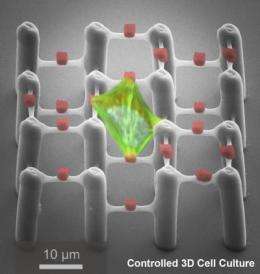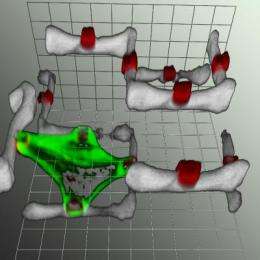Scientists develop 2-component polymer scaffolds for controlled 3-D cell culture

At Karlsruhe Institute of Technology (KIT), researchers of the DFG Center for Functional Nanostructures (CFN) succeeded in specifically cultivating cells on three-dimensional structures. The fascinating thing is that the cells are offered small "holds" in the micrometer range on the scaffold, to which they can adhere. Adhesion is possible to these holds only, not to the remaining structure. For the first time, cell adhesion and, hence, cell shape are influenced precisely in three dimensions. The team headed by Professor Martin Bastmeyer thus has achieved big progress in the field of biomaterial engineering.
So far, several approaches have been used to cell culture in three-dimensional environments which are mostly produced from agarose, collagen fibers or matrigel. They are to simulate the flexible three-dimensional reality in which the cells act normally and, hence, allow for more realistic experiments than those using cell cultures in "two-dimensional Petri dishes". All approaches used so far have one common feature: They are mostly heterogeneous with random pore sizes. They have hardly been characterized structurally and biochemically.
It was the objective of the group under the direction of Bastmeyer to develop defined three-dimensional growth substrates for the cell culture. The cells are to adhere at certain points only rather than randomly. In this way, parameters, such as the cell shape, cell volume, intercellular force development, or cellular differentiation can be determined systematically as a function of the external geometry of the surroundings. These findings are needed for the later specific larger-scale production of three-dimensional growth environments for tissue cultures required in regenerative medicine, for instance.

This objective was reached by means of a special polymer scaffold. The scaffold consists of a flexible, protein-repellent polymer with small box-shaped holds made of a protein-binding material. For scaffold construction, the scientists used the Direct Laser Writing Method (DLS) developed by the physicists Professor Martin Wegener and Professor Georg von Freymann at CFN. By means of this process, the protein-repellent structure was fabricated. It consists of 25 µm high pillars that are connected by thin bars at various heights. In a second lithography step, the holds were placed exactly in the middle of the bars. With the help of a solution of adhesion proteins, the proteins only bind to these small holds. Within two hours, individual cells colonize the scaffolds and adhere to the given adhesion points only.
For the first time, the scientists of CFN, Karlsruhe, succeeded in producing suitable materials, in which the growth of individual cells can be controlled and manipulated specifically in three dimensions. This is an important step towards the general understanding of how the natural three-dimensional environment in the tissue influences the behavior of cells.
More information: Klein, F., Richter, B., Striebel, T., Franz, C. M., Freymann, G. v., Wegener, M., and Bastmeyer, M., Two-Component Polymer Scaffolds for Controlled Three-dimensional Cell Culture. Advanced Materials, Volume 23, Issue 11, pages 1341, March 18, 2011, DOI:10.1002/adma.201004060
Provided by Helmholtz Association of German Research Centres















